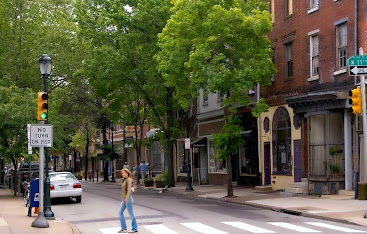Trees Along Sidewalks: Practical Advice for a Submitted Question
This week's blog is more of a Q&A on a topic I have been asked before but did not, until now, have a really good comprehensive answer. Many thanks to specialists with the Missouri Conservation Department who responded.
Q: We have a neighborhood here in one of our historic districts that has street trees that are damaging the sidewalks. We are going to facilitate a meeting for the neighbors to discuss how to handle this. Do you have a contact in the extension who might now about what kind of trees are appropriate to plant along a street that won’t pop up the sidewalk or street with their roots? I know it’s asking nature to not do what it does, but that’s where we are." - Laura Mize, Neighborhood Specialist, City of Excelsior Springs, MO
A: My suggestion is to plant nothing in the "death strip." My apology for my snarky remark, but seriously I can think of no good tree to plant in that area. I am copying my urban go-to guy, Jon Skinner. -- Hank Stelzer, University of Missouri Extension.
A: It sounds like their boulevard strips are small. Generally, anything under 6 feet in width is not suggested to plant medium to large size trees in. So, your looking at ornamentals for the most part on narrow strips. Things like eastern redbud, Japanese tree lilac, white fringe tree, downy serviceberry, etc. All of these must be pruned to develop a single stem form. Otherwise, they will have a multi-stem, shrub like appearances and interfere with traffic and pedestrians. Anymore, if a community is rebuilding sidewalks, I encourage them to create boulevard strips of at least 8 feet wide or place the sidewalk on the curb and plant behind it in the right-of-way portion of the yard. There are also technologies that allow roots to grow under sidewalks like structural soil and silva cells. These are more expensive to implement, but relieve much of the sidewalk lift issue. -- Jon Skinner, Community Forester, Missouri Department of Conservation
A: If the root plates are lifting the sidewalk, it will likely continue. You could carefully grind and relocate the sidewalks further from trees, mud jack them or remove the trees and replace. General rule of thumb is to select species that are 1/3 the width of space between sidewalk and curb at maturity. For example, to plant a 3-4’ wide oak tree you’d want about a 12-foot tree lawn ideally. I cannot quite tell from the photo what species you have there. Happy to come look in-person if you’d like. - Taylor Neff, Community Forester, Missouri Department of Conservation
A: Great information. In addition, here are some trees I’ve planted in “tree lawns” 😉 and had success with. Small: ‘Autumn Brilliance’ serviceberry and ‘Ivory Silk’ lilac (maintain tree-form), American hornbeam, Eastern redbud, royal raindrop and spring snow crabapples (pruning required after 2 yrs to lift), hophornbeam. Large: swamp white oak, white oak, bur oak, post oak, northern red oak, Shumard oak, hackberry, ‘Espresso’ Kentucky coffeetree (seedless), tulip tree, bald cypress, American linden. -- Kelly McGowan, horticulture specialist, University of Missouri Extension.





Comments
Post a Comment